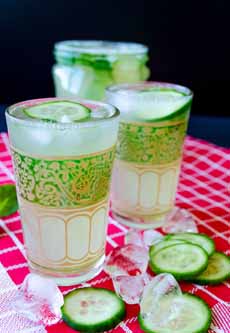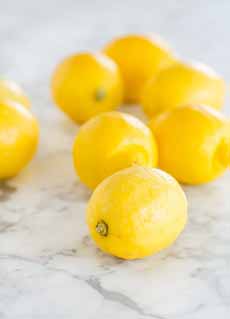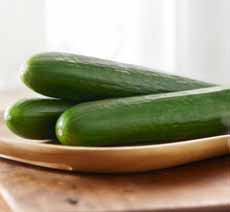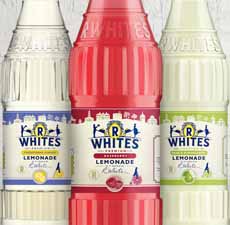RECIPE: Cucumber Lemonade For National Cucumber Day
|
How about a new lemonade recipe for National Lemonade Day, August 20th? The lemon tree first grew wild in the Assam region of India and was ultimately brought to the Middle East. While archaeological evidence shows that people drank lemon drinks centuries earlier, the first known written reference to the lemon tree dates from a 10th-century Arabic book on farming (source). The history of lemonade continues below. But first, the recipe, from Chef Kris Koch of The SIX15 Room at The Grand Hotel, Minneapolis [photo #1]. His preparation tips: National Lemon Day is August 29th. National Cucumber Day is June 14th. Ingredients 1. BLEND the ingredients thoroughly. Refrigerate until ready to serve. 2. GARNISH as desired and serve. with sliced lemon, lime, cucumber, and a sprig of mint. The history of prepared foods depends on the written record; and the further you go back in time, the fewer the written records. Lemons and sugarcane are both native to India, where an early form of lemonade called nimbu pani was consumed. It is believed that lemons were introduced to the Middle East around 700 C.E. The earliest written evidence of lemon juice drink, from Egypt, dates to around 1000 C.E., made with lemons, dates, and honey. Subsequent written records show that trade in lemon juice was active by 1104. Records of the Jewish community in Cairo, that span the 10th through 13th centuries, note the consumption of qatarmizat—lemon juice with lots of sugar—which was made for local consumption as well as export (source). In 1676, Compagnie de Limonadiers was founded in Paris, with monopoly rights to sell lemonade. Street vendors served the drink from tanks on their backs. The first known reference to carbonated lemonade comes from 1833; it was sold at refreshment stands in Britain. The R. White’s Lemonade brand, still sold in the U.K., has been produced since 1845 (photo #4). |
 This lemonade adds cucumber and a touch of lime juice (photo © Kimpton Hotels).
[3] English cucumbers. As they mature on the vine, they grow quite long (photo © Mastronardi Produce).
|
|
|
What About The Ice? Much of the early lemonade was served without ice. Refrigeration and ice in warm weather are more modern benefits. While drinking lemonade-type drinks may date back thousands of years, ice to keep foods cold was available only to the wealthy few, who could afford ice houses. In ancient times, ice cut from the mountains of Italy was shipped by barge (on a minuscule scale) to the Middle East and Egypt. The earliest remains of ice pits found are from the seventh century B.C.E., with references suggesting that the techniques were used before the 11th century B.C.E. By the Renaissance, people of means built ice houses on their properties, in shaded areas or below ground. During the winter, the ice house would be loaded up with ice and snow and packed with insulation such as straw or sawdust. The original purpose was to store perishable foods in the warm months, but the ice could also be chipped to cool drinks or make ice cream and sorbet. By the 19th century, commercial ice houses would store tons of ice for purchase. Still, ice houses could only exist where there was a source of natural ice. In 1806, Frederic Tudor, a New England entrepreneur, came up with the idea to export ice on a commercial basis. Tudor’s first shipment was to the Caribbean, and the “Ice King” ultimately shipped ice all over the world. Tudor invented an entire industry, the ice trade. Domestically, “ice men” carried blocks of ice to homes and businesses, where they were stored in “ice boxes” which kept perishable foods cool. The first home refrigerator with a small freezing compartment—it held two ice cube trays±was launched in 1923. Large “deep freezers” for retail use only became common during the 1940s. That’s why people in period novels and films went to the neighborhood drugstore to get ice cream! Big freezers did not go into mass production for home use until after World War II, and the new refrigerator-freezer units allowed people to keep lots of ice in the freezer. Automatic icemakers for home refrigerator-freezers were first sold around 1953 (source). And then: iced lemonade for everyone! |
||


